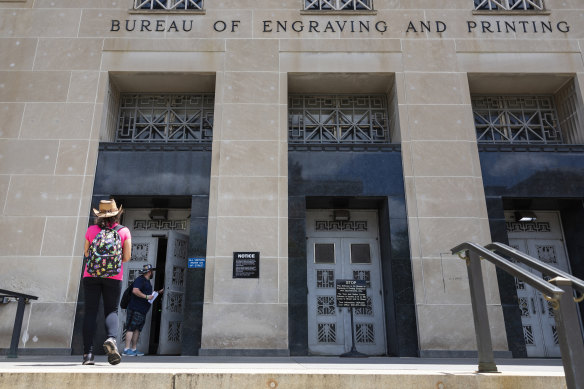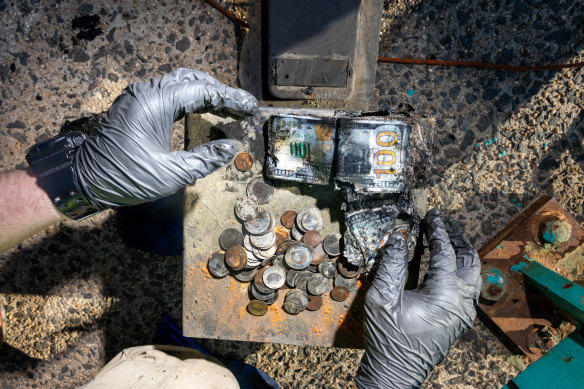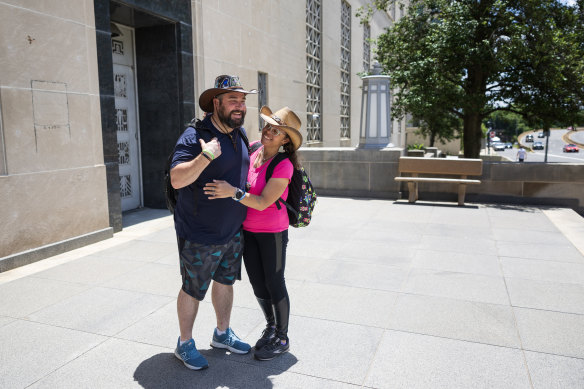This was published 4 months ago
He fished a safe full of cash out of a creek. That was the easy part
By Allie Conti
New York: James Kane was bleary-eyed as he climbed onto the upper deck of a bus, wearing a cowboy hat with stickers and carrying a backpack that contained a small fortune.
He’d only gotten three hours of sleep the night before, as the previous day had been a blur of interviews with news wires, TV stations and radio programs. He was headed to Washington, more specifically to an obscure branch of the Treasury Department that dealt with mutilated currency.

James Kane and Barbie Agostini enter the US Treasury’s Bureau of Engraving and Printing in Washington with an estimated $US50,000 to $US70,000 in waterlogged $US100 bills.Credit: The New York Times
It all started when he hoisted a safe out of a creek in Flushing Meadows Corona Park in Queens, New York. Ever since losing his job during the pandemic, Kane had been trying to establish himself as a magnet fisherman with a YouTube channel. He had the police on speed dial as someone who regularly found computer hard drives, gun parts and the occasional live grenade.
But a safe with money in it was the unspoken Holy Grail, and the responding officers said: finders keepers. The news spread to local reporters, who all wanted a piece of him and his partner-turned-videographer, Barbie Agostini.
But then the news of their record-breaking haul began to traverse time zones. The couple even got the honour of asking a question on a celebrity game show in Australia: “Hi, we’re James and Barbie from Queens, N.Y., and what did we find in the water last week?”
The answer, as breathlessly reported by The Guardian, the BBC and the New York Post – and verified only by Kane himself – was a safe containing maybe $US100,000 ($150,000). Technically, this is all he ever hoped for, though he hadn’t really planned for what would happen if he ever hit it big. Now long-lost acquaintances were coming out of the woodwork, and strangers were bombarding the family with sob stories on social media. Feeling panicked, Kane emailed the government.

Kane shows some of the cash he found in a safe he fished out of a creek.Credit: The New York Times
“All the immediate attention we’re receiving from this money is driving us a little crazy and we’re a little afraid,” he wrote. “We don’t have a lot of money so we’re going to be using whatever we have for a bus to get down there.” He also alluded to the fact that his plight was time-sensitive. The paper money, which had once been preserved in muck, was turning brittle and starting to disintegrate.
Kane thought there might be $40,000 left, tops, and that the amount seemed to be decaying with each passing day.
Back came what seemed like an automated response, albeit one with a physical address for the Bureau of Engraving and Printing on 14th Street NW, Washington DC. Having little else to go on and a sense that their future was slipping away, Kane and Agostini scraped together the $US140 round-trip bus fare. And at 6.45am this past Friday, they boarded the bus to the capital. They figured it would all work out if they got to the bureau, which deals with damaged money, before it closed for the weekend. They had no appointment, but they were hoping for the best.
“This is the most significant find in poor-people treasure-hunting history,” Kane said. “I know it’s the federal government, but I did expect a little humanity. Give us the red carpet!”
Although the clock was ticking, the couple had never really been outside New York, and they wanted to enjoy what they called a “daycation” in the nation’s capital. Kane marvelled at the natural history museum, which looked remarkably similar to the one in Manhattan. He couldn’t get over the prevalence of Lime electric scooters, which weren’t available in New York. He was certain that every waterway in Washington must be clogged with them and regretted not bringing his magnet.
But the biggest difference was that, in Washington, he felt anonymous again.
“In Queens, we can’t walk three blocks without the mailman, the pizza man, some kids on the street being like, ‘You’re that guy’!” Kane said as he made his way towards the Treasury. “They think we have the money in our pockets. But nobody knows us here, which is very strange.”
Kane walked into the Bureau of Engraving and put a six-centimetre knife, a can of pepper spray and the backpack with his waterlogged money through the metal detector. He hadn’t actually rehearsed what he would say to the security guard on the other side.
“We are treasure hunters, and we found a safe full of money that was stolen,” is what he went with. “It’s squished, and it’s been in a pond for about 10 years. It also smells terrible.”
Without skipping a beat, the guard said something into his radio, and two professionally dressed Treasury employees, a man and a woman, promptly came downstairs. Both looked unfazed as Kane repeated his treasure hunter spiel. They rifled through his backpack and pulled out a plastic bag containing a stack of money that appeared to be a solid clump about 10 centimetres. “Yeah, all of this is currency,” said the woman.
“Even the mud,” said the man.
Right there in the lobby, he estimated that Kane was holding somewhere in the range of $US50,000 to $US70,000. They and the rest of their 11-person team would need about nine months to officially count it and replace it with unblemished currency. But when they were done, the money would be his, tax-free.
“America the beautiful!” Kane said.
The bureau had dealt with much worse cases before, the woman said – people who would mail in the remnants of money their grandparents had buried in the backyard, literal dust in some cases. This prompted Kane to briefly think of all the money he had just left lying in Corona Park, assuming it was too far gone. It had probably floated all the way out to the East River by now.

Kane and Agostini don’t have a lot of money – other than what came out of the safe.Credit: The New York Times
“The world doesn’t run on money,” he said. “But I’m going to search the entire island of Manhattan when I get home. One hundred per cent.”
After being handed a case number, he and Agostini walked out of the building and embraced. They wanted to celebrate, but they weren’t rich just yet. So they approached a security guard for directions to the nearest Shake Shack.
The officer, who wore a lapel pin that said “Treasury Police”, stared at the crazy-eyed people in the plastic cowboy hats who were pointing a video camera at him. Had a colleague at the metal detector informed him about the knife and the pepper spray? An eternity elapsed.
“Where are you guys from?” the Treasury officer asked. He narrowed his eyes.
Kane stared at the officer’s holstered gun.
But then realisation struck: the officer had seen those cowboy hats on TV. This was the magnet guy from New York, the one who’d found all that money in the lake.
“Let me take a picture with you, man,” he said, reaching for his phone. “My wife is not going to believe this.”
This article originally appeared in The New York Times.